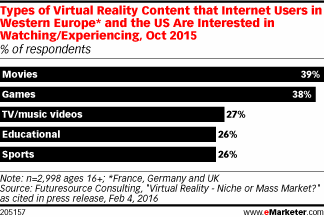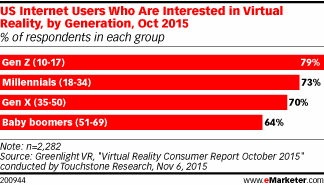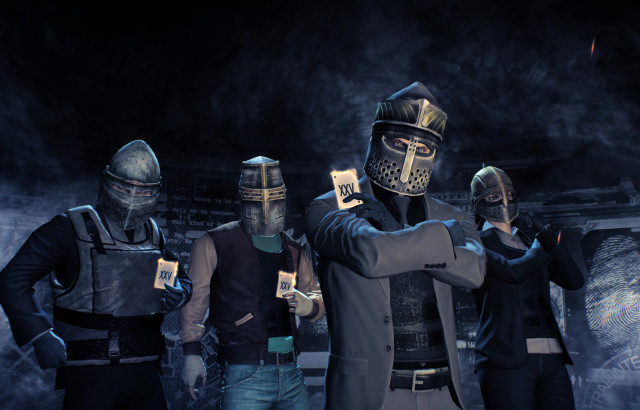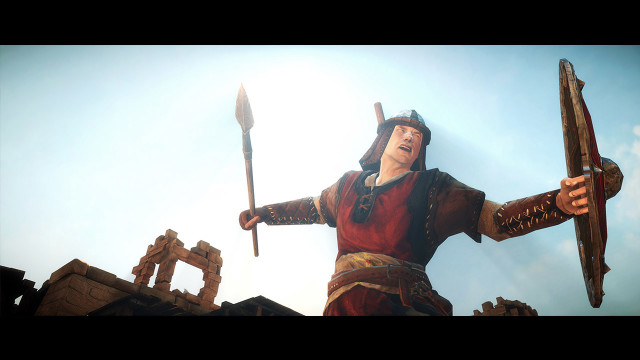Yesterday, EEDAR‘s head of insights, Patrick Walker, discussed the rapidly growing and diverse nature of the gaming universe, which will be the focus of his session at GDC titled, “Understanding Engagement in the Rapidly Expanding Gaming Universe.”
[a]listdaily talks to Walker about topics driving the video game market, such as eSports, the emergence of VR technology, how crowdfunding has helped extend player engagement, and of understanding the patterns that form a window into what consumers want.
 What do you think of Activision’s assertion that eSports can someday match or surpass revenues from traditional sports?
What do you think of Activision’s assertion that eSports can someday match or surpass revenues from traditional sports?
I think there is a roadmap for that, but it’s far away, and involves pieces falling into place, and it’s a far way off. Partly because you have to have buy-in from mainstream sponsorship at a higher level than it is currently at. When you think of the Super Bowl, the event is generating $5 million for a thirty second commercial.
This could happen with eSports, because you have a very lucrative target market that’s hard to reach through other sources, especially when it comes to live eyeballs. TV is seeing fewer live eyes with DVR, On Demand and online services.
As mainstream sponsors realize the power of this market and start to pump money into it, then we can see the value of that ecosystem start to rise. But traditional companies would need to wrap their head around a lot of new things, like people watching others play games, understand the value of streaming services like Twitch, and come to terms with how a 17-year old kid can become an international superstar by professionally playing video games.
What about all these televised eSports shows?
TV is still an incredible network for advertising, and there’s a certain Halo effect that comes from TV that makes something legitimate. One of the really interesting trends over the past couple of years has been traditional companies that used to leverage television strongly, like Activision with its Call of Duty campaigns, have started to have a growing awareness of how valuable user acquisition campaigns can be through web advertising, social media, and YouTube. They’ve shifted a lot of money towards non-traditional media.
Then companies like Supercell, King, and Machine Zone — coming from the world of free-to-play, were all about user acquisition and performance marketing, which was entirely based on mobile or web — are starting to do brand marketing, because they realize that television is still an incredibly powerful tool. It establishes a brand and a certain level of validation as a part of mainstream culture.
So, television will be a big part of that mainstream growth, but I don’t think it’ll be a straight line where television companies will just add on more content. Television is experimenting with audiences in their own way to see how they react to eSports.
When eSports are shown on ESPN, are people buying it as a sport? When eSports becomes more mainstream, will it do so as a sport that’s covered on SportsCenter, or does it become a different thing entirely?
The one thing that you can’t deny is that there is a really important segment of the population that really likes eSports and has money to spend. And because of that, eSports is never going to become a fad. How big eSports gets, or what path it takes to going mainstream, might be up in the air, but it’s an absolutely viable business.
What potential do you see with emerging technologies like VR?
I think that it’ll take about five years [for mass adoption], and some of the best applications for virtual reality will be outside of gaming, and that will drive broad engagement.
Right now, we have three premium headsets coming out, and we have the Gear VR. What people like using the Gear VR to watch movies, but they also like showing off that initial sense of presence. You can also get it into the hands of a lot of people and you can take it to a party.
You can give people a sense of presence using Gear VR, and you can get it into the hands of a lot of people. I think there might be a limited market because it relies on a high end Samsung phone, instead of supporting Android or smartphones in general, but we’re going to see similar devices. Google is making its own [non Cardboard] headset, and you’d imagine that it work with all of Android, so you’ll see a broader penetration. Apple brought in people to work with VR on iPhone.
Then you look at the premium headsets that are coming out, and they’re creating great gaming experiences. The critical gaming community is going to be really excited by these experiences. I think early adopters are going to be really big fans, but there are barriers for getting broad mainstream penetration for these units — mostly around the price of the PC hardware and headsets.
PlayStation VR is well positioned because it has the PS4 install base [over 36 million worldwide]. But it also has challenges in that Sony has historically not supported its peripherals very well. So, you have a fan base that is wondering whether PlayStation VR will have better support than the Vita or Move. Sony also hasn’t shown all of its cards. A lot could change when more information about the experiences and price point are revealed.
I think that what both the Oculus Rift and HTC Vive have going for them is that companies with long term aspirations in VR are deep pockets are supporting them. Valve is supporting the Vive and Oculus has Facebook. Facebook in general has traditionally shown more of an interest in social connection that purely games, so its long-term goals for VR must be similar.
The good news is, even if adoption is slow, these are companies that are prepared for that and are playing the 5-year game.
How has crowdfunding and Early Access helped spread awareness of games and drive user engagement?
So, I talked about the diversity of people playing the expanding game universe, and all the ways people can play and engage, including playing but not playing. But I think another trend is that you can get involved with a game over a much longer period of time, which includes pre-launch, launch, and now with games as a service you can play for a very long time.
Assuming that a product creates the perfect experience that you really want, developers can engage you with that product for an incredibly long period of time. With Kickstarter, you put money into something that you believe in, and there are a lot of genres where Kickstarter has been an amazing thing. Isometric RPGs like Baldur’s Gate had disappeared from the market, but Kickstarter was able to find these fans that appreciated this niche and helped revitalize the genre with games like Wasteland 2, Pillars of Eternity and Divinity: Original Sin.
With Early Access, you can access a game while it is in development and provide feedback. Then you move into where betas are becoming more common. Then, when the game launches, you can participate in the game continuously with microtransactions, online modes and competitive PvP.
There are some complications that arise, like games taking an extraordinarily long time to complete. With Kickstarter, you could end up with a game that doesn’t meet expectations, or reaches a funding goal but never gets made. But by and large, I think they have been a net positive for the gaming community to have more involvement.
What is the most important thing to keep in mind when looking for long-term engagement with audiences?
I think the tricky thing is not getting caught in the trap of thinking, “These things are so great that I should do all of them.”
Instead, they should ask themselves, “For the type of game that I’m making, and what the consumers want, what should I be providing?”
Does Early Access make sense for my game? Should I do a Kickstarter, or should I look for external funding? Should I do an eSport for my game? Should I build on mobile, or does it make more sense for my game to be on Steam? All of these things are levers for creating and driving engagement, but they are also opportunities strategic decisions that can be done poorly — making your game unsuccessful.






 What have been some of the best cross-promotions?
What have been some of the best cross-promotions?

